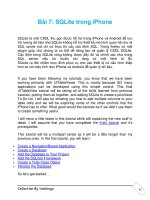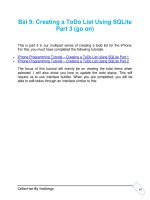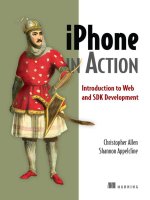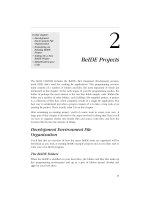iPhone Games Projects docx
Bạn đang xem bản rút gọn của tài liệu. Xem và tải ngay bản đầy đủ của tài liệu tại đây (5.4 MB, 282 trang )
Successful iPhone Game
Developers Share Their Secrets
iPhone
Games Projects
Dave Mark, Series Editor
|
PJ Cabrera
From library of Wow! eBook
www.wowebook.com
iPhone Games
Projects
DAVE MARK, SERIES EDITOR
PJ CABRERA
JOACHIM BONDO
AARON FOTHERGILL
BRIAN GREENSTONE
OLIVIER HENNESSY
MIKE KASPRZAK
MIKE LEE
RICHARD ZITO
MATTHEW AITKEN
CLAYTON KANE
iPhone Games Projects
Copyright © 2009 by PJ Cabrera, Joachim Bondo, Aaron Fothergill, Brian Greenstone, Olivier Hennessy,
Mike Kasprzak, Mike Lee, Richard Zito, Matthew Aitken, Clayton Kane
All rights reserved. No part of this work may be reproduced or transmitted in any form or by any means, electronic
or mechanical, including photocopying, recording, or by any information storage or retrieval system, without the
prior written permission of the copyright owner and the publisher.
ISBN-13 (paperback): 978-1-4302-1968-2
ISBN-13 (electronic): 978-1-4302-1969-9
Printed and bound in the United States of America 9 8 7 6 5 4 3 2 1
Trademarked names may appear in this book. Rather than use a trademark symbol with every occurrence of a
trademarked name, we use the names only in an editorial fashion and to the benefit of the trademark owner, with
no intention of infringement of the trademark.
Lead Editor: Clay Andres
Developmental Editor: Douglas Pundick
Lead Author and Technical Reviewer: PJ Cabrera
Editorial Board: Clay Andres, Steve Anglin, Mark Beckner, Ewan Buckingham, Tony Campbell, Gary Cornell,
Jonathan Gennick, Jonathan Hassell, Michelle Lowman, Matthew Moodie, Duncan Parkes, Jeffrey Pepper,
Frank Pohlmann, Douglas Pundick, Ben Renow-Clarke, Dominic Shakeshaft, Matt Wade, Tom Welsh
Project Manager | Production Director: Grace Wong
Copy Editors: Kim Wimpsett, Marilyn Smith
Associate Production Director: Kari Brooks-Copony
Production Editor: Laura Esterman
Compositor | Interior Designer: Diana Van Winkle
Proofreader: Nancy Bell
Indexer: BIM Indexing & Proofreading Services
Cover Designer: Kurt Krames
Manufacturing Director: Tom Debolski
Distributed to the book trade worldwide by Springer-Verlag New York, Inc., 233 Spring Street, 6th Floor, New York,
NY 10013. Phone 1-800-SPRINGER, fax 201-348-4505, e-mail , or visit http://www.
springeronline.com
.
For information on translations, please contact Apress directly at 2855 Telegraph Avenue, Suite 600, Berkeley, CA
94705. Phone 510-549-5930, fax 510-549-5939, e-mail , or visit .
Apress and friends of ED books may be purchased in bulk for academic, corporate, or promotional use. eBook
versions and licenses are also available for most titles. For more information, reference our Special Bulk Sales–eBook
Licensing web page at />The information in this book is distributed on an “as is” basis, without warranty. Although every precaution has
been taken in the preparation of this work, neither the author(s) nor Apress shall have any liability to any person or
entity with respect to any loss or damage caused or alleged to be caused directly or indirectly by the information
contained in this work.
The source code for this book is available to readers at . You will need to answer
questions pertaining to this book in order to successfully download the code.
To my parents, Pedro and Cecilia: LQM
—PJ Cabrera
To my brother Adam, who does 50% of the work and gets 0.01% of the mentions ; )
—Aaron Fothergill
To my teammates, past and present, who have made me the engineer I am
—Mike Lee
Contents at a Glance
Foreword xiii
About the Lead Author and Technical Reviewer xv
Acknowledgments xvii
Introduction . . . . . . . . . . . . . . . . . . . . . . . . . . . . . . . . . . . . . . . . . . . . . . . . . . . . . . . . . . . . . . . . . . xix
JOACHIM BONDO
CHAPTER 1 Simplify the User Interface for Complex Games:
Chess, the Deep Green Way 3
PJ CABRERA
CHAPTER 2 Responsive Social Gaming with RESTful Web Services 21
AARON FOTHERGILL
CHAPTER 3 Rapid Game Development Using (Mostly) Standard C 61
BRIAN GREENSTONE
CHAPTER 4 Brian Greenstone’s Jedi Master List for Game Optimization . . .101
OLIVIER HENNESSY AND CLAYTON KANE
CHAPTER 5 Starting with a Game Design Document:
A Methodology for Success 131
MICHAEL KASPRZAK
CHAPTER 6 Multiplatform Game Development:
iPhone Games for Linux and Windows 155
MIKE LEE
CHAPTER 7 Code Optimization with Mike Lee,
the “World’s Toughest Programmer” 191
RICHARD ZITO AND MATTHEW AITKEN
CHAPTER 8 Networked Games: Choosing the Right Option 215
INDEX 251
Contents
Foreword xiii
About the Lead Author and Technical Reviewer xv
Acknowledgments xvii
Introduction . . . . . . . . . . . . . . . . . . . . . . . . . . . . . . . . . . . . . . . . . . . . . . . . . . . . . . . . . . . . . . . . . . xix
JOACHIM BONDO
CHAPTER 1 Simplify the User Interface for Complex Games:
Chess, the Deep Green Way 3
Once Upon a Time . . . 4
Why Should We Care About Simplicity? 7
How Simplicity Was Achieved 7
Distilling the Essence 8
Pushing the Pixels 9
Letting the User Focus. . . . . . . . . . . . . . . . . . . . . . . . . . . . . . . . . . . .10
Drilling Down 12
Less Is More 13
Empowering the User 15
Making the User Smile 16
Summary 17
PJ CABRERA
CHAPTER 2 Responsive Social Gaming
with RESTful Web Services 21
Social Networking Games and the iPhone 22
Creating the Prototype High-Score Web Service 24
Creating the High-Scores Rails App 24
Using RESTful XML Web Services 27
Displaying High Scores on the iPhone 29
Creating the User Interface 30
Connecting to Web Services 36
Parsing XML 42
Displaying the High Scores in the Table View 46
CONTENTSviii
Submitting High Scores to the Web Service 49
Submitting User Achievements 52
Introducing ObjectiveResource 53
Using ObjectiveResource 53
Submitting High Scores with ObjectiveResource 57
Summary 57
AARON FOTHERGILL
CHAPTER 3 Rapid Game Development Using (Mostly)
Standard C 61
Getting Started 64
Creating the Project 66
Addressing the Save Game Problem 74
How to Save 74
How to Save the Easy Way 75
Space Hike: The App 81
The Render Loop and Basic Organization 81
Game Logic Overview 83
Drawing and Handling the Game 84
Enhancing the Game 97
Summary 98
BRIAN GREENSTONE
CHAPTER 4 Brian Greenstone’s Jedi Master List
for Game Optimization 101
Memory Matters 102
Parlez-vous C? 103
Straight C Is Best 103
Cocoa vs. Core Foundation 105
Compiler Optimizations 105
The Thumb Instruction Set 106
Compiler Optimization Level 108
Optimizing Function Calls 108
Audio Optimizations 109
Streaming Music Playback 109
Sound Effects with OpenAL 111
OpenGL Optimizations 112
Construct an Efficient OpenGL Draw Context. . . . . . . . . . . . 112
Avoid State Changes 114
CONTENTS ix
Reducing Texture Sizes 116
Using Compressed Textures 117
Geometry Data Reduction 118
Limit the Quantity of Draw Calls 120
Performance Tools 121
Using Instruments 121
Using Shark 123
Summary 127
OLIVIER HENNESSY
AND CLAYTON KANE
CHAPTER 5 Starting with a Game Design Document:
A Methodology for Success 131
The Game Vision 132
The Game Design Document 133
Title 133
Game Summary 133
Game Detail 134
Game Setting 134
Game System/Engine 134
Game Play: Controls and User Interface 136
Level Map 137
Aesthetic Design 138
Title and Information Screens 139
Sound Effects 139
From Vision to Reality 140
Tips for Creating Realistic Artificial Intelligence 140
Challenges of Designing for the iPhone 141
Game Development Tips 144
Solitaire Top 3 144
Backgammon 145
Pool 146
Kaleidoscope 147
Shake N’ Break 148
Bikini Hunt 149
YoYo 150
Apache Lander 151
Summary 152
CONTENTSx
MICHAEL KASPRZAK
CHAPTER 6 Multiplatform Game Development:
iPhone Games for Linux and Windows 155
The Development of Smiles: A Collection of Puzzle Games . . . 156
What Are Cross-Platform and Portability? 160
Why Write Portable Code? 160
Why Not Write Portable Code? 161
Portability from the Ground Up 162
The Classic Game Loop 162
A Practical Game Loop 163
Frames and Refresh Rates 165
Work and Draw Frame Code 165
Cooperating with an Event-Driven Operating System 167
Preparing to Track Touches 167
Tracking Touches 167
Simulating Touch and Release Events in a Game Loop . . . 170
Frame Skipping 172
Creating a Unix System Time Library 173
Using the UnixTime Library for Frame Skipping 177
Tilt and Touch Physics Sample 179
The Game Code for the Physics Simulation Sample 180
Further Portability Considerations 186
Summary 188
MIKE LEE
CHAPTER 7 Code Optimization with Mike Lee,
the “World’s Toughest Programmer” 191
Iteration 1: Particle Effects 192
The Big Picture 194
Iteration 2: Smoke and Mirrors 195
Premature Optimization 197
Build Efficiency. . . . . . . . . . . . . . . . . . . . . . . . . . . . . . . . . . . . . . . . . 197
Code Efficiency 199
Algorithmic Efficiency 201
Iteration 3: Shark Attack Time 202
Level-Headed Performance 204
Iteration 4: Increasingly Clever Optimizations 206
Application-Specific Optimization 207
Summary 211
CONTENTS xi
RICHARD ZITO
AND MATTHEW AITKEN
CHAPTER 8 Networked Games: Choosing the Right Option . . . 215
Multiplayer Networking Options 217
Communication Is Key 218
Say “Bonjour” to Local Network Gaming 224
Drawing to Screen 235
Tic-Tac-Toe, an Example 237
Summary 249
INDEX 251
Foreword
iPhone games are hot, hot, hot! As I write this, there are more than 40,000 apps on the App
Store, of which nearly 9,000 are in the Games category, the largest category by far. The next
largest category is Entertainment, at just over 5,000 apps. There are nearly 40% more games
on the App Store than any other kind of app.
Games is not only the biggest category on the App Store, but it is also the best-selling cat-
egory. During the promotion of its one billionth download, Apple provided a list of all-time
most popular apps. Of the top-20 all-time paid apps, more than 14 were games. Many of
these apps were on the top-10 paid apps list at one time or another during the nine months
the App Store had been in business. Many are still on the top-100 list. These sold thousands
of copies a day in their time, with daily revenue between a few thousand to tens of thou-
sands of dollars.
With such great numbers, it is understandable why the interest in developing iPhone games
is so high. It is probably the reason you are reading this foreword. You couldn’t have picked
up this book at a better time. If you want to get in on the fun and potential profit of making
iPhone games, the time to get started is now, and this book is your ticket there!
This book contains lots of information from master independent iPhone game developers—
information that is hard to find anywhere else. Some of the authors of this book are respon-
sible for all-time popular games:
N
Brian Greenstone developed Enigmo and Cro-Mag Rally.
N
Aaron Fothergill developed Flick Fishing.
N
Mike Lee developed the original Tap Tap Revolution, the most downloaded game in
App Store history.
This book also features a chapter by award-winning game developer Mike Kasprzak, finalist
for Best Mobile Game in the Game Developers Conference’s Independent Games Festival
Mobile 2009. Other authors, including Richard Zito, Joachim Bondo, and Olivier Hennessy,
have received glowing reviews and accolades for their games.
The content in this book is phenomenal. The authors provide a variety of points of view and
different approaches to iPhone development, showing you how iPhone games are made with
various technologies. You will gain knowledge of how to optimize your game using iPhone
SDK tools such as Instruments and Shark, as well as optimization tricks that the masters have
FOREWORDxiv
learned through the crucible of experience. You will also get invaluable insight into game
design, arguably the most important aspect of game creation. If your game is not properly
designed, all the technical prowess in the world isn’t going to help it be popular.
I am honored to have worked with the independent game development professionals in the
creation of this book. I have learned from their experience thanks to the chapters they have
written. And with this book, you, too, can acquire the know-how and insight to make the
next generation of all-time most popular and award-winning games.
Now, pick up this book and get started!
PJ Cabrera
FoneGears Systems LLC founder and lead developer
xv
About the Lead Author
and Technical Reviewer
PJ Cabrera is a software engineer with more than 12 years of experience developing infor-
mation systems in various industries, programming in C, C++, Java, PHP, Python, and Ruby.
But his real passion for many years has been hacking gadgets (i.e., turning a Sega Dreamcast
into a NetBSD router, or running Android and Debian GNU/Linux on a Palm TX) and making
home-brewed games for consoles such as Dreamcast, PlayStation 2, GameBoy Advance, and
PSP. He is very excited that he can finally share his creative side on iPhone and XBox 360 with
the general public through the App Store and XNA Community Games.
Acknowledgments
Special thanks to Glenn Cole who reviewed every chapter, provided quality control, and
contributed the introduction.
I would like to acknowledge the support of my family as I worked on this book. Thanks for
putting up with my absence every evening and weekend I had to work on my chapters, and
for your unreserved love.
And thanks to my friends Ronada Wanner, Lenny Ramirez, Cesar Otero, and Luis Pulido, for
cheering me on and believing in me.
This book would not have been possible without the tireless professionalism of many staff
at Apress. Many thanks go out to Clay Andres, for believing in me; our project manager
Grace Wong, for her gentle reminders of my looming immutable deadlines; Caroline Rose,
Kim Wimpsett, and Marilyn Smith for editing and copy editing duties (my chapter is much
improved because of their efforts); Laura Esterman, Douglas Pundik, and Glenn Cole in
production editing (the chapters look awesome!). To everyone else at Apress, thanks for
everything you did to make this book a reality.
PJ Cabrera
Introduction
First, the obvious: the iPhone rocks. Less obviously, so does the iPod touch—no phone,
no cellular network (and the associated monthly fee), just a wonderful game-playing,
application-downloading, insanely great Cocoa touch machine. Consumers love them both
for their stability, ever-present network access, ineffable coolness, and (as we developers
know firsthand) all of those great third-party apps.
Apple’s App Store rocks, too, and as the owners of these devices have made it clear, games
rock the most! The Wall Street Journal reported data from Mobclix showing that over a quarter
of the applications in Apple’s App Store are games (see
/>2009/03/23/no-recession-for-iphone-game-apps/
). Venture capitalists are getting in
on the action as well, financing game developer Ngmoco to the tune of $10 million. There has
even been a conference devoted to gaming on the iPhone (see />Think of this book as a guide and companion through your personal journey of game
development for the iPhone and iPod touch. And like any good travel guide, it’s full of tips,
highlights, and invaluable suggestions for avoiding the costly and time-consuming mistakes
of the early explorers who have gone before you.
But the life of the game developer is not all fun and, well, games, so there’s more. After all,
games development requires knowledge of the same basic coding and language skills as
any form of app development. So we’ve loaded the book with code you can reuse as build-
ing blocks for your own apps. Even those developers who don’t have game development as
their highest priority will find a lot of solid information here for use in their applications.
Who This Book Is For
This book is for everyone writing game applications for iPhone and iPod touch. It’s assumed
that you already have some development experience, both in general and specifically with
Objective-C and Cocoa on the iPhone. We have made no attempt to cover every aspect of
every API for every sort of game imaginable. We have left a lot of room for your imagination,
and have instead filled the book with key concepts and compelling stories we hope you will
find both useful and inspirational.
INTRODUCTIONxx
We’re able to do this because this book is part of Apress’s comprehensive road map of Mac
and iPhone developer titles. So, if you have experience with Objective-C and Cocoa, but not
specifically for the iPhone, Beginning iPhone Development by Dave Mark and Jeff LaMarche is
a great way to fill in the gaps. If you have experience with an object-oriented language like
C++, C#, or Java, a glance through the first few chapters of Apple’s free online reference
“The Objective-C 2.0 Programming Language” (available from le.
com
) may be sufficient before moving to Beginning iPhone Development. Otherwise, you’ll
want to begin either with Learn Objective-C on the Mac by Mark Dalrymple and Scott Knaster,
if you have experience with C but not with Objective-C, or Learn C on the Mac by Dave Mark, if
you’re starting from scratch or have not used a C-like language like PHP, ASP, or JavaScript.
Just as some portions of the iPhone SDK are based on standard C rather than on the Cocoa
frameworks, so, too, do some portions of this book use standard C pointers and structs. If
you are not comfortable with these, Expert C Programming by Peter van der Linden (pub-
lished by Prentice Hall) will help to bring you up to speed.
What’s in the Book
The journey begins by giving serious consideration to the user experience. We’ve all heard
that an application should be well polished before being released, but what does that really
mean? Joachim Bondo, author of the elegant chess application Deep Green, shares his
thoughts on what makes a great user interface, and how he decides which features to add
and which to leave out. Seeing all of the thought that went into Deep Green will show you
what polish really means.
In Chapter 2, PJ Cabrera shares his ideas on bringing back the social aspect of games. He
backs this up with code to show how to call a web service, how to parse the resulting XML,
how to post data back to the web service, and for truly RESTful web services, how to simplify
the task with a drop-in library. As a bonus, you will also see how to prototype a RESTful web
service using Ruby on Rails, so you can get started quickly.
Long-time developers will appreciate how the old text game Star Trek has evolved into using
OpenGL ES in the game Space Hike. Aaron Fothergill explains the process in Chapter 3, and
also shares a nifty technique for saving struct-based data.
Chapter 4 finds “rock star” Brian Greenstone of Pangea Software—makers of Bugdom, CroMag
Rally, and more—sharing his “must-do” list for iPhone action games. Brian also guides you
through performance analysis using both Instruments and Shark. The first time I read this
chapter, I was exhausted by the end.
In Chapter 5, Olivier Hennessy and Clayton Kane share some of their tricks of the trade in the
form of the game design document (think of it as a plan for success). They also provide an
overview of the available game engines and why you should consider using one.
INTRODUCTION xxi
Are you thinking about other platforms as well as the iPhone? In Chapter 6, Mike Kasprzak
shares his techniques for writing an OpenGL ES–based game for the iPhone that can also run
on Windows and on Linux with minimal changes. Also included are techniques for “frame
skipping” and physics simulation.
Mike Lee—previously of Delicious Monster, cofounder of Tapulous, and now at Apple—
shares his insights on the code optimization process in Chapter 7. Mike goes into the
thought process behind optimization, including key observations that help drive toward a
solution. He also makes a strong argument for embracing the vendor’s frameworks, even
when you’re tempted to roll your own.
The book concludes with Richard Zito and Matthew Aitken writing about multiplayer gam-
ing. They explore the various techniques for networking, demonstrating the pros and cons
of each. Low-level sockets are covered, both with and without Bonjour. You’ll learn how to
“publish” the game’s availability on the network, and how to allow users to join in.
We’ve also added a special online bonus chapter by Jamie Gotch on how to implement a
clone of the game Puyo, a falling blocks game, using the A* (A-star) path-finding algorithm.
A* is typically used to implement artificial intelligence for unit movement in genres such
as real-time strategy, adventure, and role-playing games. This chapter shows how to use
A* to find adjacent blocks of the same color in the game. Jamie’s game Fieldrunners was
the winner of the Game Developers Conference’s Independent Games Festival Mobile 2009
competition.
There is something here for everyone, from experienced OpenGL developers, to enter-
prise software developers, to those who have completed only an introductory text. I know,
because I’ve read every chapter and checked every line of code. It has been an illuminating
journey through applications so diverse and rich with experience that I kept finding new
surprises and deeper insights. I hope you get as much out of this book as I have.
Glenn Cole
Joachim Bondo
Company: Cocoa Stuff (one-man shop)
Location: Copenhagen, Denmark
Former Life As a Developer: I have 27 years of experience in starting
up and running smaller software development companies and devel-
oping software using a wide range of programming languages, such
as BASIC, COMAL 80, Pascal, C, C++, Objective-C, SQL, NewtonScript,
PHP, JavaScript, and Bash. I’ve worked in many environments, such
as THINK C and Think Class Library (TCL), Macintosh Programmer’s
Workshop (MPW), Metrowerks CodeWarrior and PowerPlant, 4th
Dimension, Newton Toolkit (NTK), Sybase, MySQL, TextMate, Xcode,
Cocoa, and Cocoa Touch. Platforms include Mac OS 3–8, Newton OS,
Palm OS, Unix (FreeBSD and Mac OS X), Mac OS X Panther and Leopard,
and iPhone OS.
Life As an iPhone Developer: I created Deep Green, a chess game, using
the official iPhone SDK from Apple (since the day it was released).
What’s in This Chapter: With the focus on creating a beautiful, elegant,
and powerful user interface, and in a noncode language, the chapter
covers the key areas that made Deep Green a successful application in
the App Store, featured by Apple in several sections such as What’s Hot
and Staff Favorites.
Key Technologies:
N
User interface design
N
Simplicity
N
Product statement
19682Ch01.indd 1 5/13/09 8:14:26 PM









